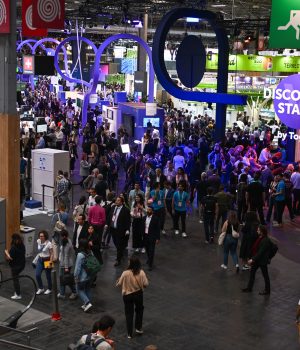Being Anticipatory as a leader or an organization is not necessarily a sole act of seeing the future, although paying attention to Hard Trend future certainties and seeing disruptions of any kind before they occur may make it seem so.
An Anticipatory mindset that embodies an entire organization or specific leader within an organization means they have also embraced the reality that change is always occurring.
Anticipation gives the right individual the opportunity to get in front of that change and turn it into a transformation within their industry and the world! The beauty of my Anticipatory Organization® Model is that any and every organization in any and every industry can leverage it to their advantage.
To do so, it helps to first read about how certain organizations changed their mindset before creating positive disruptions and transformations in and outside of their operation. Their level of pushing the envelope all relates in some way or another to the common principles of my Anticipatory Organization Model.
3 case studies of contemporary Anticipatory organizations
Chipotle – Known for assembly line-style customization of entrees, this fast-food chain took advantage of the disruptive pandemic of 2020 to more efficiently incorporate the digital technology that has already been in motion long before COVID-19: online ordering.
Instead of having to run food out to customers who ordered online like curbside delivery, Chipotle has restructured many of its restaurants to have what they call “Chipotlanes,” or designated drive-thru areas that service only mobile orders.
Anticipatory Organization Principle: Skip It Principle
Chipotle identified a Hard Trend future certainty in mobile applications that they already implemented. Instead of having to deal with both the COVID-19 pandemic and a potential buildup of online orders inside their restaurant, they simply skipped that problem and created a system to double a location’s revenue and operational efficiency!
IBM – IBM is a textbook example of a trailblazing organization, one that frequently utilizes my Anticipatory Organization Model in reinventing the computer software industry time and time again. However, around the early 1990s, IBM saw a massive downturn in their main source of income in building computer hardware as the industry became immensely saturated.
Thinking quickly about the future of their organization, executives and business leaders at IBM shifted to an Anticipatory mindset and pivoted their focus to the software side of the business. In addition to programming software, this era brought them into the realm of IT consultancy and computing research to continue servicing customers in technology.
Anticipatory Organization Principle: Going Opposite
Even if you think that your cash cow cannot possibly be disrupted, it will. IBM did not let their massive organization crash and burn when hardware became less profitable for them. They went in the opposite direction and promptly got involved in the other side of the computer technology industry, finding success and other opportunities in software.
Corning – The name of this organization may not immediately ring a bell to you; however, their place in the glass and ceramic world has undoubtedly impacted your kitchen at one point or another. Their inception started when this glass manufacturer had a contract to produce the glass for Thomas Edison’s light bulbs.
When that cash cow eventually began to dry up, the leaders at Corning looked more openly at what they were capable of producing with glass. The focus became using their same manufacturing process to eventually create durable cookware, and from there evolved into a virtually indestructible glass utilized in today’s iPhones, Apple Watches, and other smart devices.
Anticipatory Organization Principle: Exponential Thinking
Corning noticed quickly that they were not a light bulb manufacturing company — they were a glass production organization. Their exponential thinking around what was possible with the glass and ceramic materials they were capable of producing led them to a level of business longevity most of us cannot fathom, being founded in the mid-1800s.
Steps to take toward becoming an Anticipatory organization
Those three Anticipatory Organization examples highlight just a few of the many principles of my Anticipatory Organization Model. While they may help you home in on how you might leverage any one of those principles for a specific product, service, or business process at your organization, taking the following steps is more applicable for making a holistic switch to an organization-wide Anticipatory mindset.
Master Hard Trends – Most critical thinking techniques are easier said than done; however, this one is easier than you think! Hard Trends are trends we are certain will happen, or will continue. One example that we can be certain of is that adaptive technology (artificial intelligence, for instance) will get smarter. How might that impact your industry in the future? Identifying the Hard Trend and its influence on your industry helps you in the next step.
Pre-Solve Future Problems – Hard Trends are unavoidable, and you will have to deal with the problems they may bring eventually. In identifying Hard Trends, suddenly anything that may disrupt your organization in the future comes into focus and becomes solvable and predictable. Develop a solution for these issues firsthand, no matter if they impact your product, service, or process.
Become the Positive Disruptor – Future problems may not only affect your organization; in many cases, but disruptions also interrupt the lives of your customers. By pre-solving a problem that your organization will eventually have, you may also be pre-solving problems your customers are unaware they will ever have, putting you in the driver’s seat of the industry in a remarkable way.
Starting with these three steps builds a good foundation for the ability for your organization to skip over problems that aren’t really problems, go opposite on products and services, or think exponentially about your place in your industry. By having a handle on the future in an Anticipatory way, you also establish a united Futureview within your organization, creating an environment of innovation and measurable productivity.
Become an Anticipatory Organization with Daniel Burrus’ transformation acceleration business model that transforms planning and accelerates innovation and growth.
For more entrepreneurship tips, subscribe to our weekly newsletter and follow us on Twitter, Facebook, Instagram and LinkedIn.







